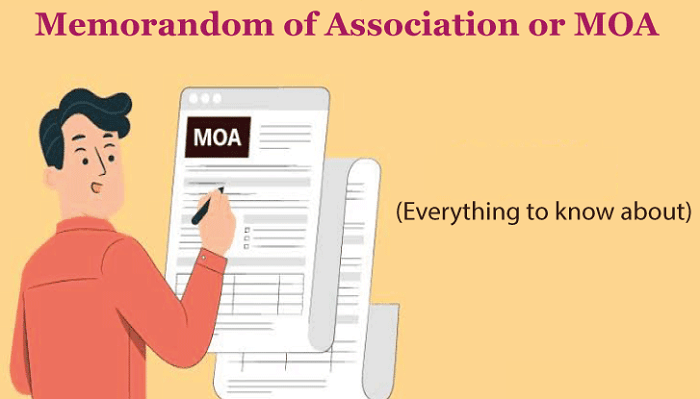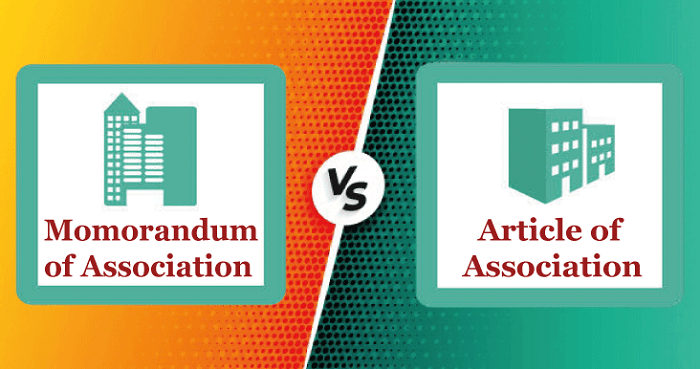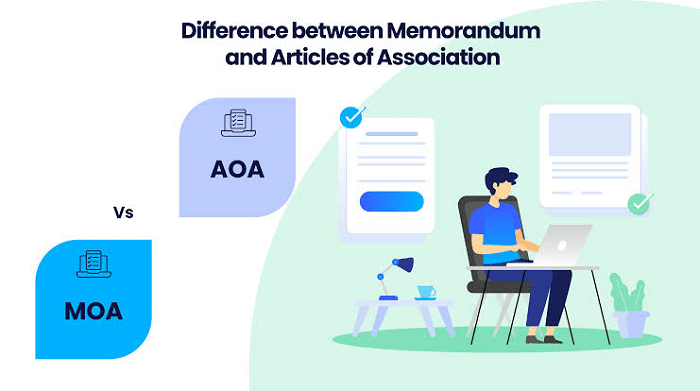Difference Between Memorandum Of Association And Article Of AssociationThe two key papers that establish the groundwork for a company's creation and operation are the Memorandum of Association and Articles of Association. The name, location of the registered office, capital, purposes, and responsibility terms are all included in the Memorandum of Association. The bye-laws, or rules and regulations, that control a company's internal operations, management, and way of doing business, are included in its articles of association. Both of these documents need to be submitted to the Registrar of Companies when a business is formed. 
The MOA is the foundation upon which the firm is founded because it outlines the company's charter. AOA, on the other hand, consists of bye-laws that control the organization's internal operations, management, and behavior. When a business applies for incorporation, both MOA and AOA call for registration with the ROC. Memorandum of Association (MOA)The first and most crucial step in the formation of a corporation is the drafting of a memorandum of association. According to the 2013 Companies Act, this is indeed one of the requirements for establishing any kind of business. The foundational document upon which a company's constitution and organizational structure are created is the memorandum. It outlines the goals the proposed business will work toward, the bounds of what it may do, and its interactions with other people and entities. 
It was noted that a company's memorandum is its charter document, outlining the bounds of its authority, in the well-known case of Ashbury Railway Carriage & Iron Co. Ltd. vs. Riche (1875). It outlines the scope of the legal authority granted to the corporation and makes clear that nothing may be done outside of that scope. The notion of ultra vires forbids an organization from acting in a manner that is not consistent with the powers or purposes set forth in the Memorandum. Thus, even if all members agree to it, the act is invalid and doesn't bind the firm. In India for now, a MOA is a prerequisite for incorporation. The firm must be registered with the Registrar of Companies at the moment of incorporation. It limits the range of endeavors that the company may engage in by enclosing the powers, objectives, and scope of a corporation within which an organization is not authorized to function. Any person who interacts with the firm is deemed to have read it. I.e., they must be familiar with the goals and focus of the business. Anyone who interacts with the firm, such as shareholders, creditors, investors, etc., is said to have read the company, meaning they are expected to be familiar with its goals and scope of activities. The Memorandum is frequently referred to as the company's charter. The Memorandum is subject to the following six conditions:
Articles of Association (AOA)The secondary document, known as the Articles of Association (AOA), sets forth the policies and guidelines adopted by the business for day-to-day management. The articles also outline the obligations, privileges, rights, and responsibilities of the company's directors and members. Additionally, it contains details regarding the company's accounting and audits. While the memorandum specifies the company's scope and powers, the articles of association, wherein the members can draft and alter, set down how the company's goals are to be carried out. The Companies Act and the memorandum's limitations, however, must be respected by them. Every firm needs its own set of articles. A public corporation limited by shares, however, may choose to use Table F in place of the Articles of Association. It includes all pertinent data on the internal management and operations of the company. It is created for all company employees, including directors, employees, and members. The rules described in this document serve as the company's rules of governance. The articles of association for the firms can be drafted in accordance with their needs and preferences. The memorandum of association is the supreme governing document for a corporation, and its memorandum supersedes and governs the articles of incorporation, which are ultra vires if they include any provisions that go beyond the memorandum. The articles, however, are only internal company rules over which the corporation's members have total control and may make changes as they see right. Therefore, only care should be made to ensure that the guidelines outlined in the articles are not exceeded beyond the company's capabilities as defined by its memorandum. Memorandum of Association vs. Articles of AssociationThe following are the main differences between the articles of association and the memorandum: 
1. Meaning The memorandum of association, which serves as the company's charter, lays forth the primary requirements and objectives for which an incorporation certificate will be granted. The articles of association include the rules and regulations that govern how the organization is internally managed. 2. Alteration The association's memorandum cannot be changed easily. Only changes made in accordance with the Act's guidelines are permitted to the memorandum's provisions. A Court or the Central Government may need to approve changes in particular circumstances. By way of a special resolution, members do, nevertheless, have the authority to change the articles of association. Generally speaking, it is not necessary to get permission from the Supreme Court or the Central Government in order to amend the articles. Additionally, pursuant to Section 15(1), each amendment to the articles of incorporation or bylaws of a company shall be set down in each and every copy thereof, as the case may well be. For every copy of both the article or memorandum issued without the required change [Section 15(2)], if a company violates the provisions of Section 15(1), the firm and any official who violates them are liable to a fine of Rs. 1,000. 3. Overriding Effect It is forbidden to include any language in the memorandum of association that thus conflicts with the Companies Act's rules. It should be highlighted that the Companies Act shall take precedence over any provisions of a company's memorandum that are in conflict with the Act (Section 6). The Memorandum of Association and the Companies Act come before the articles of association. Alternatively stated, nothing that is illegal, against the terms of the memorandum, or in conflict with the rules of the 2013 Companies Act may be found in the articles. 4. Members' Relationships The articles regulate the connection between the entity as well as its members as well as between the members themselves, whereas the memorandum describes the relationship between both the entity and third parties. 5. Ratification of Acts Done Beyond the Scope As was previously said, any actions taken by an entity that are not covered by the memorandum are void and unenforceable and cannot be approved even by a majority of the shareholders. The shareholders, however, have the power to ratify board decisions that are not covered by the articles (as long as they are not ultra vires the memorandum).
6. Format A Memorandum of Association must follow the format outlined in Section 4(6) of the Companies Act. Any of the forms listed in Tables A, B, C, D, or E of Schedule I to the Act may be used by a firm, depending on the sort of business it is.
A corporation can either fully or partially follow the model Articles of Association outlined in the Act, such as
7. Contents Of These Documents A memorandum's information is as follows:
The bylaws set forth the guidelines that an organization has created for its internal activities. The following details should generally be included in the articles:
MoA vs AoA Comparison Chart
ConclusionThe two essential legal papers for a company are its articles of association and memorandum of association. Both of these publications provide guidance to the business on many topics. They also aid in the efficient management and operation of the business. Due to this, it is required that every corporation write its articles and memorandum. It is generally advisable to study a company's memorandum and articles before doing business with it in order to get a good understanding of the company's operations, the Board's authority, its relationships with stakeholders, and other related matters.
Next TopicDifference between
|
 For Videos Join Our Youtube Channel: Join Now
For Videos Join Our Youtube Channel: Join Now
Feedback
- Send your Feedback to [email protected]
Help Others, Please Share










